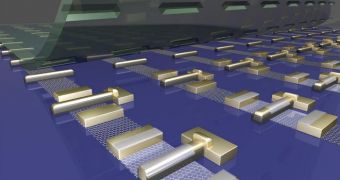Since first produced in 2004, graphene has garnered a lot of interest from the international scientific community, especially for its potential applications in the field of electronics. In a new study, experts found a way of producing graphene-based transistors with great efficiency.
The main issue with this material is that it's very difficult to produce in bulk, which considerably slows down research efforts in this field. When scientists at the University of Manchester first produced the compound, they used duct tape and graphite from a pencil lead.
Now, 8 years and more than 3,000 research papers on graphene later, scientists can produce the material more readily, but the process is still complex. Including the material in other structures, such as transistors, is even harder.
Yet, scientists at the University of California in Los Angeles (UCLA) appear to have found a way of synthesizing graphene-based transistors in a manner that they say is scalable. What this means is that the approach can be used to create very large amounts of such transistors at once.
Graphene is a 2D carbon compound that has the thickness of a single atom. All carbon atoms that make it up exist in a fixed, hexagonal arrangement, which confers the material some interesting properties.
UCLA researchers announce that they can now fabricate self-aligned graphene transistors with transferred gate stacks. The achievement was made possible through the efforts of a multi-disciplinary research team, featuring scientists from multiple departments and institutes at the university.
Their approach overcomes the challenges of conventional fabrication by “performing the conventional lithography, deposition and etching steps on a sacrificial substrate before integrating with large-area graphene through a physical transferring process,” a statement from the UCLA reads.
“The research demonstrates a unique, scalable pathway to high-speed, self-aligned graphene transistors and holds significant promise for the future application of graphene-based devices in ultra–high-frequency circuits,” the research group writes.
Details of the new work appear in a paper entitled “High-frequency self-aligned graphene transistors with transferred gate stacks,” which is published in the July 2 online issue of the esteemed journal Proceedings of the National Academy of Sciences (PNAS).

 14 DAY TRIAL //
14 DAY TRIAL //